General Farsi Unicode Information | |||||||||||||||||
Writing Farsi Text: In the past, both the web page programmer and the casual reader had to use the same Farsi font. Typically, this meant that the reader had to find a site from which to download and install the same Farsi font that was used by the Farsi writer in order to view the Farsi web page. However now, a reader does not have to download special Farsi fonts, since Farsi characters are available in several standard Unicode fonts. 1. First, Windows 2000 has to be configured with the Windows Farsi keyboard. The instructions to select a language keyboard are given in Windows 2000: Language Settings. 2. Next, start the Microsoft Word 2000 —a word processing program. 3. Next, the EN (English keyboard) has to be changed to the FA (Farsi keyboard) to type Farsi text. This selection is made by clicking with the mouse on the EN near the bottom right-hand corner of the monitor screen. After FA has been selected, it should replace the EN the bottom right-hand corner of the monitor screen. The result is illustrated in the following image.
4. The Farsi letters that will appear in the Word document will correspond to Windows 2000 Farsi keyboard maps.
Reading Farsi Text in Internet Explorer: Some of the details on configuring both Internet Explorer and Netscape are given on the side-linked pages. Click on the appropriate web browser that is named on the side bar of this page. 1. While in Internet Explorer, click on Tools --> Internet Options --> Languages --> Add. Scroll down and find Farsi [fa] and click on it. The click on OK.
2. While in the Internet Options, click on Fonts and click on the drop-down menu for Language script:. Select Arabic. Next select a font such as Times New Roman or Arabic Transparent. Then click OK.
If there are difficulties with Internet Explorer configurations, please let me know. I have not been able to do many tests. Last edited 01-18-2002 |
Useful Windows Farsi Unicode Fonts: Times New Roman, Simplified Arabic, Arabic Transparent are available on the Windows 2000 installation disk. Borna Rayaneh and Shahedy have libraries of freely downloadable Farsi fonts that are Unicode compatible. B Lotus and B Nazanin is a good choice for standard Farsi text. Other fonts offer decorative options. Farsi Freelance has Farsi fonts that are Unicode compatible and they may also be embedded in a PDF file. David McCreedy's Gallery of Unicode Fonts lists, displays, and indicates where the font may be obtained. Arabic True Type Open Fonts Pack has some useful Arabic and Farsi fonts. Farsi Simple Bold is freely available to download from this Microsoft site as an executable file (arafonts.exe). It comes with other fonts too. After it is downloaded, click on arafonts.exe to install the fonts. Useful non-Microsoft Farsi Unicode Font: Nesf is a Unicode Farsi font that may be freely downloaded from Persian Digital Library in Iran. Useful Unicode Links: Unicode Consortium Useful Unicode Charts: Index for Unicode HTML Reference Useful Keyboard Layouts and keyboard suppliers: Microsoft Windows Keyboard Layouts Farsi Text Search: Sample Farsi Text:
After the web browser is properly configured and the two fonts (Farsi Simple Bold and Nesf) are downloaded and installed, the Sample Farsi Text above should display the Farsi letters correctly. The Gif Image of the Sample Farsi Text correctly displays the Farsi letters below. The Sample Farsi Text above should look similar to the Gif image below. Gif Image of The Sample Farsi Text:
There is information on Unicode in the Persian language on the official Unicode web site.. This web page offers a good example of a Persian web page encoded in Unicode. Tahoma is the Unicode font that used to display the Persian text. John 3:16 in the Farsi language with Times New Roman font.
| ||||||||||||||||
jueves, 27 de mayo de 2010
General Farsi Unicode Information
Suscribirse a:
Enviar comentarios (Atom)
Correo Vaishnava
Archivo del blog
-
►
2015
(1)
- ► septiembre (1)
-
▼
2010
(61)
- ► septiembre (3)
-
▼
mayo
(15)
- HTML ASCII Reference - The ASCII Character Set
- Typing Arabic and Farsi Numerals
- Smoothing Screen Fonts
- Outlook 2000
- Outlook Express 5
- Netscape Messenger 4.7
- Netscape
- Internet Explorer
- Windows XP: Language Settings
- Windows 2000: Language Settings
- General Unicode Information
- General Farsi Unicode Information
- Unicode in Internet Explorer 5, 5.5 and 6
- Unicode in Firefox for Windows
- UNICODE - Internet Explorer
-
►
2009
(25)
- ► septiembre (2)
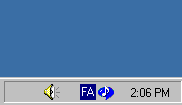
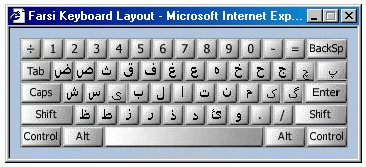
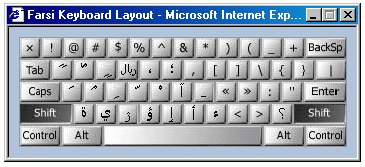
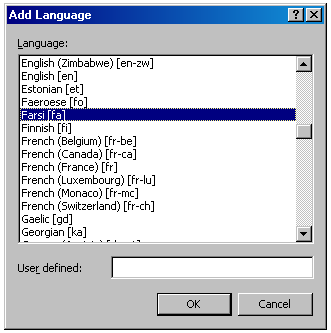
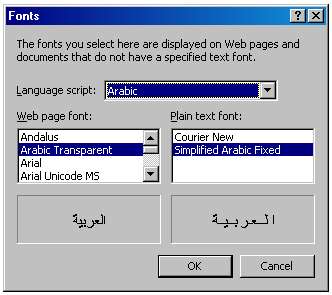
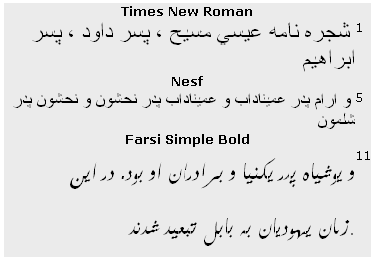

No hay comentarios:
Publicar un comentario